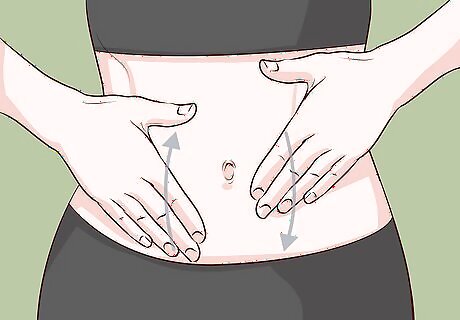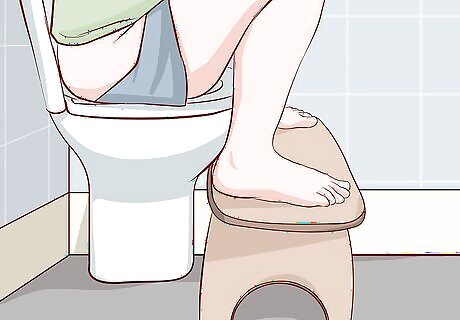
views
Using Simple Relaxation Techniques

Practice deep breathing while focusing on your sphincter muscles. Breathe in slowly and deeply for about 4 seconds, then exhale slowly for another 4 seconds. As you do this, concentrate on how your sphincter muscles feel. As you feel the other muscles in your body relax, allow your sphincter to relax as well. Repeat this process as many times as necessary in order to get your muscles to relax. Aim to do this at least 15 times, but there are no downsides to doing deep breathing for longer than this! To locate your sphincter muscles, pretend you're trying to prevent yourself from passing wind or trying to hold in a bowel movement. When you do this, you should feel your sphincter muscles around your anus tighten. You may find it easier to concentrate on your sphincter muscles by consciously tightening and relaxing your sphincter a few times before you begin your deep breathing.

Meditate to get rid of stress and release the tension in your muscles. In a seated position, close your eyes and take slow, deep breaths through your nose. Focus on your breathing in order to clear your mind and allow the muscles in your body to relax. Typically, your sphincter muscles will also relax as a result of this meditative practice. For best results, meditate in a quiet, distraction-free environment. This will make it easier for you to clear your mind and expel the tension in your body. Don't be discouraged if meditation doesn't work the first time you try it. You may need to practice it a few times.

Massage your lower stomach with your fingers. Lie down and apply light pressure with the tips of your fingers on your stomach just below your ribs. Use a stroking motion or small circles down the left side of your abdomen to your hips. Then use your right hand to massage across the bottom of your ribs to the left side of your body before going down your side again. Finally, start at your bottom right side near your hip and massage up toward your ribs. Repeat the other strokes to finish the massage. Repeat the massage as many times as you need until you feel comfortable.

Prop your feet up in a seated position to relax your pelvic muscles. If you're trying to make a bowel movement, it will be easier for your sphincter muscles to relax if your pelvic muscles are also relaxed. To do this, prop your feet on a small footstool while sitting on the toilet so that your knees are bent and are higher than your hips. Sitting this way not only relaxes your muscles, but also reduces constriction in your large intestine and rectum, which helps relieve constipation. Lean forward with your hands on your thighs to maintain an even more effective toilet position. Always sit on your toilet while using the bathroom instead of hovering over it so your pelvic muscles properly engage and relax.

Use your finger to relax your sphincter if nothing else works. Apply lubrication to your index finger, then insert your finger into your anus. Move your finger around in a circular motion until your sphincter muscles relax. This process may take a few minutes, but as long as you're using lubrication, it shouldn't be too painful. If you're not allergic to latex, wear a disposable latex examination glove while you're doing this to prevent contamination. You can buy medical lubricant at any pharmacy or drugstore. Note that this method will probably induce a bowel movement, so only do this somewhere you can get to a toilet relatively quickly.
Seeking Medical Treatment

See your doctor to determine the cause of your tight sphincter muscles. If you've suffered from constipation or tight sphincter muscles for 2 weeks or longer, it may be due to a broader medical condition. Your doctor might be able to tell you what's making it difficult for you to relax your sphincter and what you may need to do in order to fix it. Other potential causes of constipation and tight sphincter muscles include muscle damage, nerve problems, childbirth, or the overuse of laxatives.

Use a muscle relaxant if you can't relax your sphincter naturally. For best results, use a relaxant that functions specifically to relax your sphincter muscles (instead of other muscles in your body). Be sure to talk to your doctor about taking muscle relaxants before you opt for this treatment method. You may also need to get a prescription for this type of muscle relaxant from your doctor, as in many cases it's not available over the counter. The most commonly prescribed muscle relaxant for sphincter muscles is dicyclomine.

Visit a pelvic floor therapist to learn biofeedback techniques. Biofeedback involves gaining greater visual and physical awareness of your bodily functions. It's often used to strengthen the rectal sphincter, but can also be used to teach you how to relax your sphincter. It usually takes about 3 sessions with a specialist to start seeing improvement in your symptoms. Your primary care physician can refer you to a pelvic floor therapist after your initial appointment.

Opt for surgery to treat your sphincter if your doctor recommends it. In some rare cases, an inability to control one's sphincter muscles may require surgery to treat. Be sure to work with your doctor to rule out all other treatment methods first, as this is definitely the most extreme option. This type of procedure falls under the category of colorectal surgery. There are a number of different surgeries that are used to treat sphincter issues. An inability to relax your sphincter may be treated by placing an artificial sphincter around your anus that can be manually controlled.




















Comments
0 comment